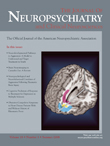A Case of Difficult Diagnosis of Rabies in the Absence of a Dog Bite in a Patient With Depression
SIR: Symptoms characteristic of rabies are hydrophobia, agitation, and irritability. Some cases present with depressive symptoms frequently termed as “silent rabies.” History of contact with a diseased animal is usually available for a diagnosis of rabies. In the absence of history and classical symptoms, rabies may be missed in the differential diagnosis.
Case Report
A 46-year-old man was brought into the emergency room by his wife at around 11 p.m. At the time of presentation he had a melancholy look on his face and was heaving and hyperventilating at irregular intervals. History revealed that he had been receiving treatment for depression as a consequence of business loss a few months back. He was known to have mood swings and to fluctuate between states of depression and anxiety. Since his business loss, he had been taking amitriptyline. His wife explained that his depression had increased after his dog died 10 days before. The patient made no mention of any untoward symptoms in the dog that could have resulted in its death. The patient’s appetite and food intake had decreased, but were adequate. He had no history of any other significant medical conditions. He was admitted for observation and given alprazolam, 0.25 mg, with a provisional diagnosis of anxiety. A psychiatric consultation was arranged for the next day. Blood samples were sent for CBC, blood glucose, and electrolytes.
At around 2 a.m. on the same night his wife called us to see him. His hyperventilation had increased and he appeared restless and irritated. His laboratory test results were within normal range. We started an intravenous line and he was given 2 mg of lorazepam. Because his hyperventilation continued unabated, we transferred him to the intensive care unit. An emergent opinion was sought from a neuropsychiatrist, who suspected rabies. To confirm diagnosis, we ordered a lumbar puncture and skin biopsy. We started him on human cell diploid vaccine; and gave him 1 ml in the deltoid. Family members were also started on prophylactic immunization. He had no bite marks, so a local vaccination was not considered. He was transferred into isolation, but despite all of our supportive measures, he died 2 days after admission. Results that were available, meanwhile, showed the presence of antibodies for rabies in the spinal fluid and presence of the rabies antigen in the skin biopsy.
Discussion
This patient presented with hyperventilation, which is commonly seen in patients with anxiety and a history of depression. The nature of presenting symptoms and history had favored the initial diagnosis of a state of anxiety and depression. The death of the patient’s dog was viewed as one of the compounding factors rather than as a triggering factor. The absence of classical symptoms like hydrophobia and opisthotonus in this patient further prevented an initial straightforward diagnosis of rabies.
Rabies is a zoonotic disease caused by lyssavirus and human infection by the rabies virus and usually occurs as a result of a bite or scratch by an infected animal. Transmission may also occur when infectious material, usually saliva, comes into contact with the victim’s mucosa or fresh skin lesions or on very rare occasions through inhalation of virus-containing aerosol. In this case, the route of transmission is unknown but probably due to the latter two reasons.
The virus first binds to receptors on the muscle cells, resulting in mild fever and pain. This patient had no history of fever or pain. The virus later affects the nerves, resulting in pain or paresthesia at the wound site. As the virus spreads in the central nervous system, progressive encephalitis develops. Brainstem encephalitis is fatal and is characterized by hydrophobia or aerophobia, hyperactivity, and fluctuating consciousness. Phobic reflexes involve jerky inspiratory spasms as observed with this patient that may end in opisthotonos, generalized convulsions, and cardio respiratory arrest. Bizarre behavior and a lack of focal neurological signs are common features. Priapism has been reported in some cases due to autonomic dysfunction. 1 However, rabies can present without classical symptoms of hydrophobia, as seen in this case. The disease is almost always fatal and without intensive care the patient will die within a few days. To prevent a fatal outcome, therapy must be initiated before the virus reaches the CNS and clinical signs appear. In this case, because of a lack of a clear history, the patient delayed post-exposure immunization. Although rabies was subsequently confirmed, the patient's history and presenting symptoms provided no straightforward explanation for the fatal outcome. Hence a diagnosis of rabies was not considered in the emergency room.
Clinicians in countries where rabies is still reported should consider its diagnosis while probing history in patients who mention death or sickness of their pet.
1. Dutta JK: Rabies presenting with priapism. J Assoc Physicians India 1994; 42:430Google Scholar



